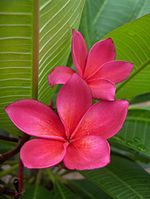Plumeria (common name Frangipani; syn. Himatanthus Willd. ex Roem. & Schult.) is a small genus of 7-8 species native to tropical and subtropical Americas[citation needed]. The genus consists of mainly deciduous shrubs and trees. P. rubra (Common Frangipani, Red Frangipani), native to Mexico, Central America, and Venezuela, produces flowers ranging from yellow to pink depending on form or cultivar. From Mexico and Central America, Plumeria has spread to all tropical areas of the world, especially Hawaii, where it grows so abundantly that many people think that it is indigenous to that island system.
Contents[hide]
|
[edit] Plant
Plumeria is related to the Oleander, Nerium oleander, and both possess poisonous, milky sap, rather similar to that of Euphorbia. Each of the separate species of Plumeria bears differently shaped leaves and their form and growth habits are also distinct. The leaves of P. alba are quite narrow and corrugated, while leaves of P. pudica have an elongated oak shape and glossy, dark green color. P. pudica is one of the everblooming types with non-deciduous, evergreen leaves. Another species that retains leaves and flowers in winter is P. obtusa; though its common name is "Singapore", it is originally from Colombia. Frangipani can also be found in Eastern Africa, where they are sometimes referred to in Swahili love poems.[1]
Plumeria flowers are most fragrant at night in order to lure sphinx moths to pollinate them. The flowers have no nectar, and simply dupe their pollinators. The moths inadvertently pollinate them by transferring pollen from flower to flower in their fruitless search for nectar.
"Plumeria" species are easily propagated by taking a cutting of leafless stem tips in Spring and allowing them to dry at the base before inserting them into soil. They are also propagated via tissue culture both from cuttings of freshly elongated stems and aseptically germinated seed.
[edit] Etymology and common names

The genus, originally spelled Plumiera, is named in honor of the seventeenth-century French botanist Charles Plumier, who traveled to the New World documenting many plant and animal species. The common name "Frangipani" comes from an Italian noble family, a sixteenth-century marquess of which invented a plumeria-scented perfume.
In Mexico, the Nahuatl (Aztec language) name for this plant is "cacalloxochitl" which means "crow flower." It was used for many medicinal purposes such as salves and ointments.
Depending on location, many other common names exist: "Kembang Kamboja" in Indonesia, "Temple Tree" or "Champa" in India, "Kalachuchi" in the Philippines, "Araliya" or "Pansal Mal" in Sri Lanka, "Champa" in Laos, "Lantom" or "Leelaawadee" in Thai. Many English speakers also simply use the generic name "plumeria".
[edit] In culture

They are now common naturalised plants in southern and southeastern Asia, and in local folk beliefs provide shelter to ghosts and demons. The scent of the Plumeria has been associated with a vampire in Malay folklore, the pontianak. They are associated with temples in both Hindu and Buddhist cultures, though Hindus do not use the flowers in their temple offerings.
In several Pacific islands, such as Tahiti, Fiji, Hawaii, New Zealand, Tonga and the Cook Islands Plumeria is used for making leis. In modern Polynesian culture, it can be worn by women to indicate their relationship status - over the right ear if seeking a relationship, and over the left if taken.
P. alba is the national flower of Nicaragua and Laos, where it is known under the local name "Sacuanjoche" (Nicaragua) and "Champa" (Laos).
In the book "A Varanda do Frangipani" by Mozambican author, Mia Couto[2] the shedding of the tree's flowers serves to mark the passage of time, and the conclusion sees the protagonists submerging into the tree's roots as the ultimate solution to fix their shattered world.
In Bangladeshi culture most white flowers, and particularly plumeria (Bengali: চম্পা chômpa or চাঁপা chãpa), are associated with funerals and death.